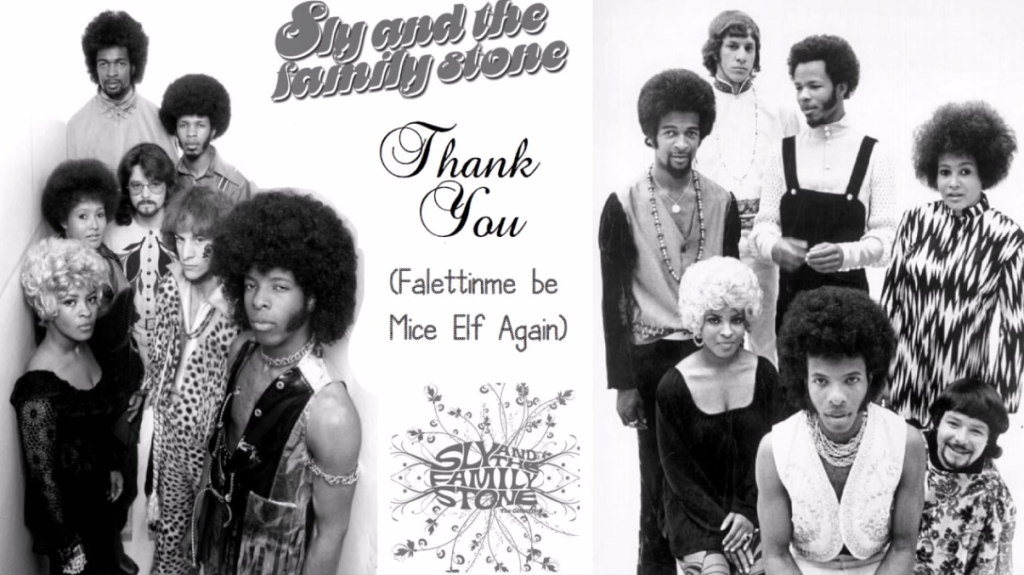When you talk about music legends from the late ’60s and early ’70s, Sly & the Family Stone is a name that stands tall. Not only did they define an era with their explosive blend of soul and funk, but they also broke barriers with their racially and gender-diverse lineup—truly a symbol of unity and change. Their 1969 hit “Everyday People” was their first No. 1 on the Billboard Hot 100, catapulting them into stardom. But just as they seemed to be riding a wave of unstoppable success, they released another chart-topper that year—“Thank You Falettin Me Be Mice Elf Agin.” Unlike their earlier, more cheerful tunes, this song carried a darker, more complicated vibe, while still delivering that irresistible funk groove.
If you’ve heard the song but never quite grasped its emotional layers, you’re not alone. Unlike upbeat party anthems like “Dance to the Music” or the communal warmth of “Everyday People,” “Thank You” feels like a party where something’s gone off script. You can almost hear the unease, the subtle panic beneath the surface—a band starting to fray at the edges.
At that time, tensions within Sly & the Family Stone were rising. Bandleader Sly Stone was wrestling with mounting pressures—both from the spotlight and his personal life. Behind the scenes, the band’s camaraderie was crumbling. Sly himself was battling health issues, substance use, and a growing sense of isolation. A former manager once described him as a “kid torn apart,” caught between despair and the demands of fame.
I’m reminded of a friend of mine, Tom, a 30-year-old designer in New York City who’s a huge fan of funk. He once told me that “Thank You Falettin Me Be Mice Elf Agin” resonates deeply with him—not because it’s a typical party tune, but because it’s honest. The song captures that feeling of struggling to keep up appearances while battling inner doubts. “It’s like the music is saying even the most talented people can feel lost and fragile,” Tom said. “That honesty makes it real.”
Musically, the song is anchored by Larry Graham’s iconic slap bass, which bubbles up with infectious energy. But the rest of the band sounds weary—horns are hesitant, the guitar scratches nervously, and the drums seem weighed down. Vocals overlap chaotically, lacking the tight-knit harmony of earlier hits, as if everyone is shouting over one another rather than singing together.
Lyrically, Sly Stone paints vivid images of his turmoil. He opens with an image of running from a gun-toting devil, then moves to a party scene where he’s visibly unsettled: “Thank you for the party, but I could never stay / Many things on my mind / Words in the way.” Later, he references the band’s past hits with a detached, almost dismissive tone—except for one line, “Papa’s still singing / You can make it if you try,” which feels like a desperate plea to hold on. The song closes on a haunting, barely audible note: “Where do we go from here? / Dying young is hard to take / Sellin’ out is harder.”
So how did this moody, uneasy funk anthem become a No. 1 hit? Mainly because of its unforgettable chorus—bold, loud, and defiantly grateful. The crowd-shouting title line cuts through the song’s anxious undercurrents, inviting listeners to lose themselves in the groove. Sly himself explained in his autobiography that the phrase “mice elf” was intentional—a playful way to say “myself” while symbolizing humility and the struggle to stand tall in a world full of obstacles.
A London-based musician I know, Lisa, told me how much she connects with this song. As an indie artist, she feels it perfectly captures the conflicted emotions many creatives face—between craving success and feeling overwhelmed by reality. For Lisa, the song’s rough edges and uneasy rhythm echo the push-and-pull of pursuing a dream in an unpredictable world.

By the time “Thank You” hit the charts at the dawn of 1970, it wasn’t just another funk tune—it was a sign of where funk was headed. Rawer, grittier, with heavier bass lines and a darker undertone, it helped pave the way for the next decade’s sound. Alongside hits like The Isley Brothers’ “It’s Your Thing” and Charles Wright’s “Do Your Thing,” it marked a shift toward funk that wasn’t afraid to show its scars.
“Thank You Falettin Me Be Mice Elf Agin” topped the Billboard Hot 100 in early 1970, replacing Shocking Blue’s “Venus,” and stayed there for weeks. Though eventually replaced by Simon & Garfunkel’s soothing “Bridge Over Troubled Water,” it opened the door for more emotionally complex No. 1 hits—like Three Dog Night’s “Mama Told Me Not to Come,” which feels like a continuation of the uneasy party scene Sly described.
Over the decades, “Thank You” has remained one of Sly & the Family Stone’s most beloved songs. It’s been inducted into the Grammy Hall of Fame and listed by the Rock & Roll Hall of Fame as one of the 500 Songs That Shaped Rock and Roll. Covered by artists from Gladys Knight to Van Morrison and Soundgarden, and sampled heavily—most famously by Janet Jackson on her 1989 hit “Rhythm Nation”—the song’s legacy endures.
This isn’t just a funky dance track. It’s a raw, honest snapshot of an artist—and a band—grappling with fame, pressure, and the struggle to stay true to themselves. And maybe that’s why, more than fifty years later, it still speaks so powerfully.
